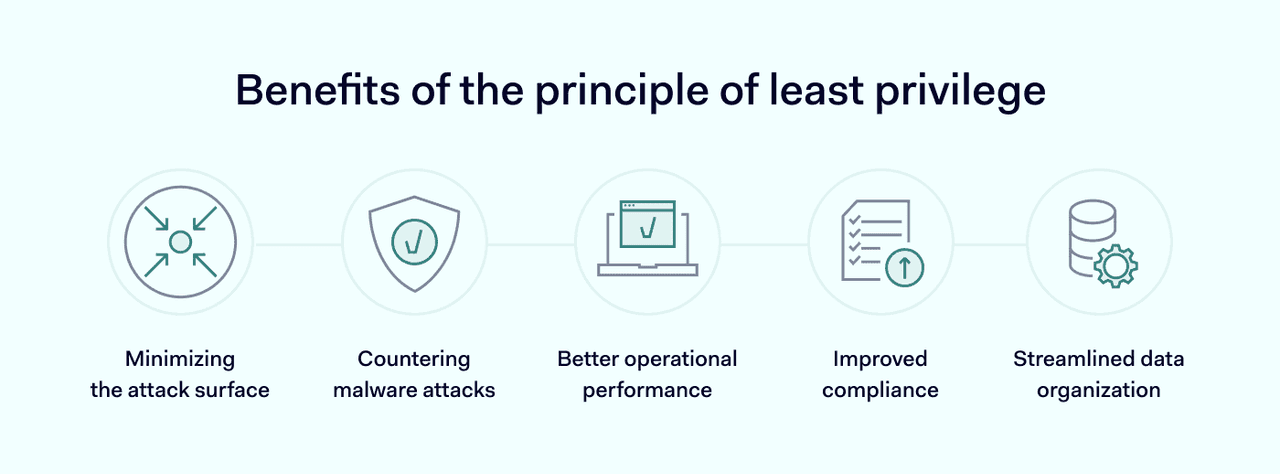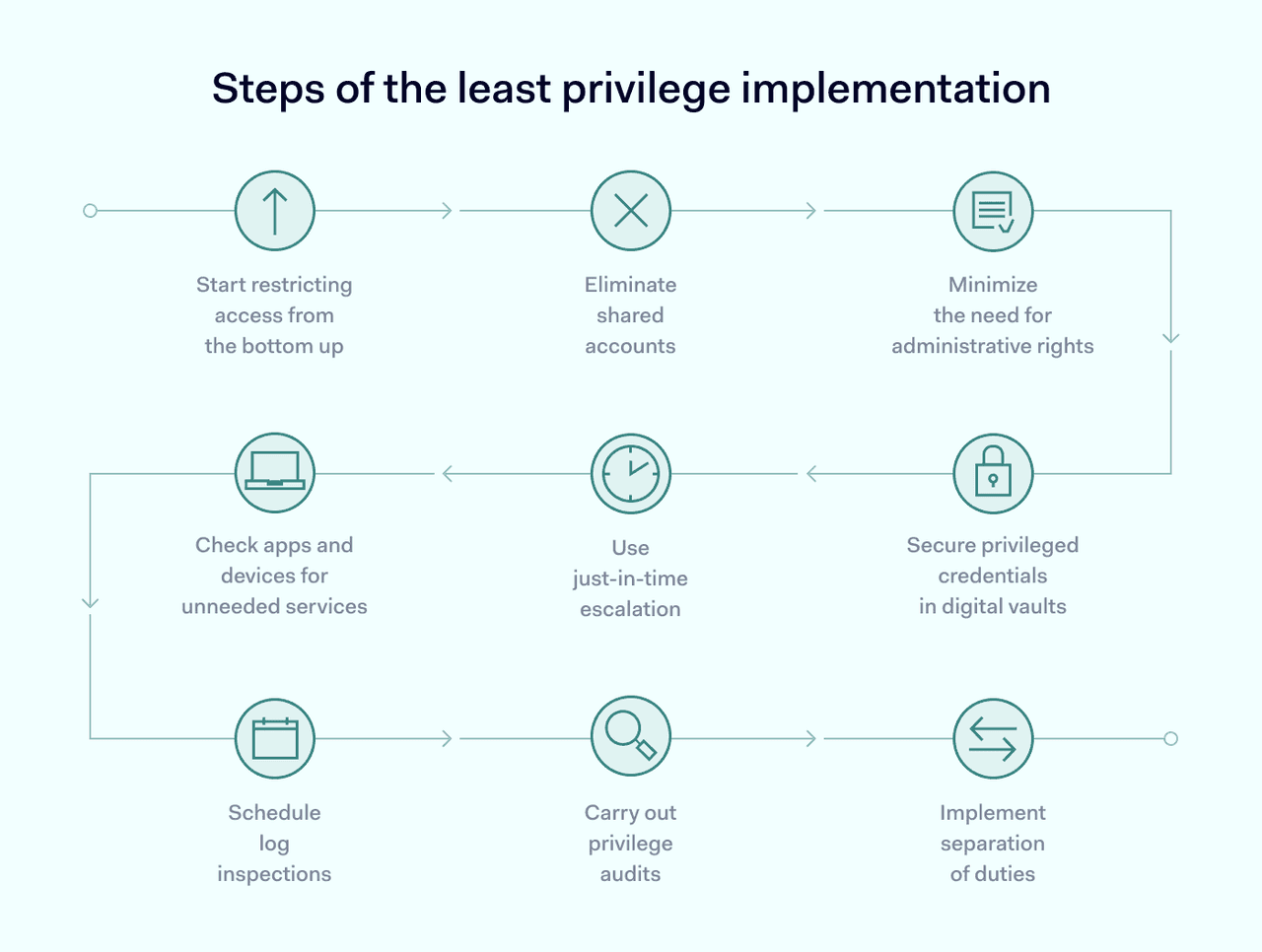Everyone knows that when it comes to security, less is often more. But how do you apply that to people's access rights across your network? The principle of least privilege (PoLP) is essentially the idea that every user, application, or device should only have the bare minimum permissions they need to do their job-nothing extra.
Think of it as controlling the blast radius: if an account gets hacked, you want to make sure the intruder can't run wild across your entire system. That's what the principle of least privilege is designed to prevent.
Principle of least privilege definition
The principle of least privilege (PoLP) states that network users should possess the privileges needed to carry out their duties or role. But beyond those core privileges, user permissions should be minimal.
Least privilege access is closely associated with Zero Trust Network Access (ZTNA). PoLP is a core part of ZTNA solutions because it shrinks the attack surface. It enables network admins to contain malware, restrict intruders, and limit the scope to move or delete data without approval.
How does the principle of least privilege (PoLP) work?
According to the principle of least privilege, users should have sufficient privileges to carry out their duties. At the same time, users should not have access to network resources or data that are not connected to their role.
The principle does not just apply to human users. Non-human entities (or subjects) also operate within network boundaries. APIs and other applications can run scripts and manipulate data. Security teams also need to limit their privileges without compromising performance.
There are many ways to implement PoLP. The most basic forms limit user capabilities via hardware alterations. For example, removing USB sockets prevents the use of external storage devices.
Enterprise-wide privileged access management systems are more complex. In these systems, users possess bundles of privileges according to their role in the organization. Human and non-human users have privileged credentials that let them complete essential tasks, but nothing more.
Access control tools dynamically assess access requests and user behavior. They allow administrators to track users regardless of ports, protocols, devices, or applications. The system prevents access if users contravene their privileges. It also generates access logs and audit streams. This makes it easier to prove compliance and prevent privilege creep—the gradual accumulation of unnecessary access rights over time—by regularly assessing user access rights.
Examples of least privilege access
Access systems based on least privilege are common in the business world, and they serve many purposes. Common applications of the concept include:
Protecting financial data
Financial companies use the principle of least privilege to separate roles and protect data. HR officers can consult payroll records but not client data. Account managers can access records of their clients, but not those handled by colleagues. Only administrators can make system-wide changes. Any actions relating to confidential data require sign-off from another senior manager.
Escalating DevOps privileges
DevOps teams in health-related businesses usually can't access patient records. But developers may need to escalate privileges temporarily to carry out database maintenance. In this case, systems based on least privilege revoke temporary access rights as needed. The coder can carry out their work but won't have permanent access to sensitive data.
Reducing phishing risks
Companies ignoring the principle of least privilege face a heightened risk from phishing attacks. For instance, remote workers may request admin rights on their home laptops. If the user opens a malicious attachment, these rights might allow malware to spread throughout connected devices. Restricting privileges limits the scope of phishing attacks of this kind.
Benefits of the principle of least privilege

The principle of least privilege is a core component of robust cybersecurity systems. And there are many reasons to implement least privilege concepts. Benefits include:
- Minimizing the attack surface. Least privilege principles keep your attack surface small. External attackers who gain access cannot spread freely throughout network resources. Attacks are confined and managing threats is much simpler.
- Countering malware attacks. Least privilege principles minimize the power of individual accounts. Malware entering the network rarely has access to over-privileged accounts. This limits the damage from most common malware attacks.
- Better operational performance. Least privilege principles boost the productivity of IT teams. Administrators create streamlined policies to manage access, including just-in-time requests for elevated privileges. Users have clear roles and access rights, and IT teams can focus on what matters. Improved security also reduces downtime, raising general productivity.
- Improved compliance. Implementing the principle of least privilege is part of compliance requirements for companies subject to HIPAA, Sarbanes-Oxley, and PCI-DSS regulations. Limiting access to sensitive information reduces the risk of data breaches. Privilege audit trails and daily logs generate the evidence required to meet compliance requirements.
- Streamlined data organization. IT teams can use privileged access management to organize and simplify information security practices. Assigning privileges establishes who has access to resources. This information is a useful baseline to use when assessing cyber-attacks.
Challenges of applying the principle of least privilege
Implementing least privilege concepts sounds simple. Administrators connect each user or role with the resources they need. Access control lists, RBAC systems, and firewalls block off other resources until told otherwise.
However, putting in place the PoLP can be challenging in larger organizations. There are various reasons why:
- Matching roles and access rights can be extremely complex. The assets used by employees may change rapidly, outpacing access controls.
- Admins can become deluged by requests for privilege elevation. This cancels the operational performance benefits of applying least privilege principles.
- Users may also seek other ways to access data or apps. For example, they may use spreadsheets on remote devices, exposing sensitive data to external attackers.
- Admins may lose control of obsolete accounts. Unused accounts may retain administrative rights. But identifying and deleting them is time-consuming.
Who does the principle of least privilege apply to?
The principle of least privilege applies to all network users (or "subjects"). There are no exceptions. Access management systems should cover any subject interacting with network objects. All human and non-human users connecting to network resources require relevant privileges and access restrictions.
Least privilege access affects everyone. This includes senior managers, super-users, or third parties. And restrictions apply to least-privileged users at the bottom of the organizational hierarchy. Nobody is exempt.
How to implement the least privilege
Implementing PoLP security starts with understanding how users interact with network resources. Identify all privileged accounts and the user access they require. Inventory connected apps and devices as well. Include on-premises and cloud assets, DevOps environments, and remote access devices.

When you have a clear picture of access management requirements, you will be well-placed to implement least privilege ideas. Here are some best practices to remember when doing so:
- Start restricting access from the bottom up. Classify every user account as "least privileged". Then add account privileges as required. Don't automatically transfer existing privileges from legacy roles.
- Eliminate shared accounts. Administrator privileges should be linked to single accounts. Regularly audit privileged accounts to make sure this remains the case.
- Minimize the need for administrative rights. Keep over-privileged accounts to a minimum. A good rule is reducing the number to 10 percent of all active accounts.
- Secure privileged credentials in digital vaults. Quarantining privileged credentials reduces the risk of external attacks and makes it easier to prevent administrator account sharing.
- Use just-in-time escalation. Instead of permanently assigning admin privileges, use temporary elevation. Record all escalations, user activity, and time periods.
- Check apps and devices for unneeded services. Audit non-human subjects to remove potential vulnerabilities. Change default settings and disable services you don't require.
- Schedule log inspections. Inspect access logs at least once a week, and more frequently if possible. Leverage automation to deliver alerts about suspicious requests.
- Carry out privilege audits. Carry out audits of roles and privileges as regularly as possible. Avoid privilege creep by removing temporary privilege escalations. Consult stakeholders for feedback about access rights and policies.
- Implement separation of duties. Put in place independent approval for all important administrative actions. This limits the power of users to migrate data or compromise network systems.
What violates the principle of least privilege?
This quick checklist of violations should help you maintain access controls and audit user privileges.
- Excessive user privileges. Does the user account have too many access rights to carry out their duties? Ensure roles match the privileges users require.
- Unsecured admin accounts. The privileges of every administrator account must be regularly audited. And credentials of high-level users must always be secure.
- Shared accounts. User accounts may be shared between groups of users. Prohibit this practice in security policies. Check for shared credentials in access audits.
- Permanent privilege elevation. Users may need elevated privileges. But permanent elevations can lead to security vulnerabilities and privilege creep.
Least privilege access and Zero Trust
If you've heard the term Zero Trust floating around, you might be wondering where the principle of least privilege fits in. The connection is actually simple and critical.
Zero Trust is a security mindset that operates on the core belief that you should "never trust, always verify." It means that whether someone is connecting from inside or outside the office, you treat them the same: as potentially compromised. Now, imagine you're a hacker who manages to steal a verified user's login. If that user's account only has the bare minimum access required (thanks to the principle of least privilege), you're instantly stopped dead in your tracks. You can't start rooting around in the company's financial servers or HR data because the permissions aren't there.
In short, least privilege is the practical muscle behind the Zero Trust framework. Zero Trust is the strategy, and the principle of least privilege is the primary enforcement mechanism that limits risk across the environment. You can't truly practice Zero Trust without strictly limiting access rights. It's what keeps a single breach from turning into a company-wide catastrophe.
Conclusion: implementing the principle of least privilege
Implementing the principle of least privilege enhances security, prevents privilege creep, and reduces the risk of potential cyber threats. But it can also present challenges such as increased complexity and problems with user experience. Find a streamlined PoLP setup that suits your information security needs.
